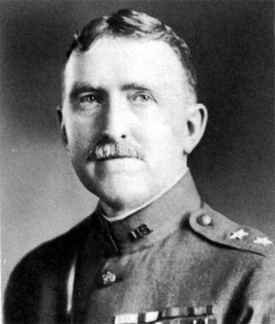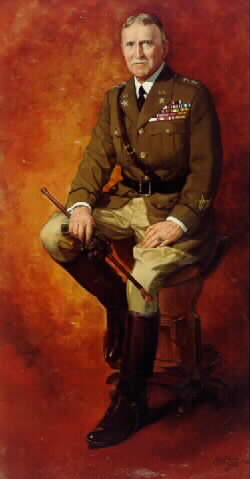John Leonard Hines (May 21, 1868-October 13, 1968) was an American soldier, who served as Chief of Staff of the U.S. Army from 1924 to 1926.
He was born in White Sulphur Springs, West Virginia. He graduated from the United States Military Academy at West Point, in 1891, and was commissioned a second lieutenant of Infantry. His first assignment was to the 2nd Infantry Regiment, and he served with the regiment in Nebraska and Montana from 1891 to 1898.
Hines served in Cuba during the Spanish-American War and in the Philippines during the Philippine-American War. He was adjutant of the Mexican Punitive Expedition in 1916-17 under General John J. Pershing.
During World War I, Hines commanded the 1st Brigade, 1st Division, from May to August 1918 and the 4th Division from August to October 1918. He received the Distinguished Service Cross, the second-highest U.S. Army decoration for valor, for “extraordinary heroism in action near Berzy-le-Sec, France, July 21, 1918.” In October 1918, he took command of III Corps, leading it during the final engagements of the war and the occupation of Germany.
Post-war commands included the 5th Division, the 2nd Division and the VIII Corps Area.
In December 1922, he was assigned as Deputy Chief of Staff of the Army, and became Army Chief of Staff on September 14, 1924. His Army biography states that as Chief of Staff, he “stressed the need for balance in funding and personnel for all parts of the permanent establishment, pointed up the effects of strength deficiencies upon Army capability to meet the provisions of the National Defense Act of 1920, and urged action on housing and promotions to promote personnel retention.”
In 1926, after completing his tour as Army Chief of Staff, Hines took command of the IX Corps Area in California, which he led until 1930. In 1930, Hines became commanding general of the Department of the Philippines. He retired in May 1932.
Hines died in Washington, DC, at Walter Reed Army Medical Center at age 100. He is buried at Arlington National Cemetery. The only American generals to have celebrated their 100th birthdays are John L. Hines, James Alward Van Fleet, and William Glascow as of 2006.
On May 5, 2000, the United States Postal Service issued the Distinguished Soldiers stamps in which Hines was honored.
Hines’ son, Col. John L. Hines, Jr. (1905-1986), served in World War Two with the 6th Armored Division, commanding the division’s Combat Command A from November 1944 to March 1945. He was twice decorated with the Distinguished Service Cross and was severely wounded outside Frankfurt, Germany when an antitank shell grazed his face.
- Awards and decorations
- Distinguished Service Cross
- Distinguished Service Medal
- Knight Commander of the Order of St Michael and St George (UK)
- Commandeur Légion d’honneur (France)
- Croix de guerre (France)
- Commander Order of Léopold (Belgium)
- Order of the Crown (Italy)
- Medal of Solidarity, 1918 (Panama)
Born in White Sulphur Springs, West Virginia, on May 21, 1868, John L. Hines graduated from West Point in 1891.
With the outbreak of the Spanish-American War in 1898, he volunteered for combat duty and was awarded the Silver Star.
In 1900, Hines was promoted to Captain and served against the Moros in the Philippine Insurrection. Promoted to Major, he served with General John J. Pershing as adjutant general of the 1916 Mexican expedition in pursuit of Pancho Villa.
Following the U.S. entry in World War I, Hines became assistant adjutant general of the American Expeditionary Force in France.
Promoted to Colonel, he took command of the 16th Infantry Regiment in November, 1917. Shortly thereafter, Hines led a brigade of the First Division at the Battle of Soissons and the Second Battle of the Marne.
For “extraordinary heroism in action,” he was awarded the Distinguished Service Cross. In August, 1918, Hines was promoted to Major General, commanding the Fourth Infantry Division during the American operations at St. Mihiel and Meuse-Argonne. Near the end of the war, Hines led the Third Army Corps during the occupation of the Rhineland. Hines was the only American officer during World War I to command successively in battle a regiment, brigade, division and corps.
In September 1924, he succeeded General Pershing as Chief of Staff of the Army. Hines retired in May, 1932, and was promoted to general in June, 1940. Hines died on October 13, 1968, and was buried in Arlington National Cemetery.
HINES, JOHN L.
Brigadier General, U.S. Army
1st Infantry Brigade, 1st Division, A.E.F.
Date of Action: July 21, 1918
General Orders No. No. 10, W.D., 1920
Citation:
The Distinguished Service Cross is presented to John L. Hines, Brigadier General, U.S. Army, for extraordinary heroism in action near Berzy-le- Sec, France, July 21, 1918.
At a critical time during the battle southwest of Soissons, when liaison had been broken between the 16th Infantry and 26th Infantry, and repeated efforts to reestablish it had failed, General Hines, then in command of the 1st Infantry Brigade, personally went through terrific artillery fire to the front lines of the 16th Infantry, located its left flank, and, walking in front of the lines, encouraged the troops by his example of fearlessness and disregard of danger. He then succeeded in finding the right forward elements of the 26th Infantry and directed the linking up of the two regiments, thereby enabling the operations to be pushed forward successfully.
Born at White Sulphur Springs, West Virginia, May 21, 1868, he graduated from West Point in 1891 and was commisioned in the Infantry. He was stationed for several years at Fort Omaha, Nebraska, and was promoted to First Liutenant in April 1898.
He served with the Quartermaster Corps in Cuba during the Spanish-American War and was advanced to Captain in December 1900. He saw action during the Philippine Insurrection, 1900-01, and was there again in 1903-05.
For serveral years was on Quartermaster and Adjutant duty at various posts, advancing to Major in May 1912. In 1916, he was appointed adjutant to General John J. Pershing for the Mexican Punitive Expedition. In May 1917, he became Assistant Adjutant General, American Expeditionry Forces in France, receiving the temporary rank of Colonel. In November his rank became permanant and he took command of the 16th Infantry Regiment. In April 1918 he was promoted to Brigadier General, taking command the next monthof a Brigade of the 1st Division under General Robert Bullard. He was promoted to temporary Major General in August and commanded the 4th Division in the St. Mihiel and Meuse-Argonne Offensives until October when he succeeded Bullard as commander of III Corps, with which he remained until its deactivation in July 1919. He was the only U.S. commander in World War I to lead a regiment, brigade, division and a corps in combat.
In November 1918, he was promoted to permanant Brigadier General and commanded successively the 4th Division, November 1919-September 1920; the 5th Division, September 1920-July 1921. He was promoted to Major General in March 1921 and took command of the VII Corps Area, October 1921-December 1922.
For two months thereafter, he served as Deputy Chief of Staff of the Army, and became Army Chief of Staff, Septmember 1924, remaining in that post until November 1926. In October 1930 until his retirement in May 1932, he was commander of the Department of the Philippines.
In June 1940 he was advanced to the rank of Full General on the retired list. He died at the age of 100 in Washington, D.C. on October 13, 1968. He was buried in Section 7 of Arlington National Cemetery. Note that he was 100 years of age at the time of his death.
His wife, Rita Wherry Hines (1876-1958), is buried with him.
His son, John Leonard Hines, Jr., Colonel, U.S. Army (March 8, 1905-November 19, 1986) and his son’s wife, Ova Richmond Hines (August 29, 1938-August 20, 1981) are buried in a lot adjacent to his. John L. Hines, Jr. (1905-1986), served in World War Two with the 6th Armored Division, commanding the division’s Combat Command A from November 1944 to March 1945. He was twice decorated with the Distinguished Service Cross and was severely wounded outside Frankfurt, Germany when an antitank shell grazed his face
HINES, JOHN LEONARD
- GEN U.S.A.
- DATE OF BIRTH: 05/21/1868
- DATE OF DEATH: 10/13/1968
- BURIED AT: SECTION 7 SITE 8001 R.1
- ARLINGTON NATIONAL CEMETERY
HINES, RITA W W/O JOHN LEONARD
- DATE OF BIRTH: 05/23/1876
- DATE OF DEATH: 03/07/1958
- BURIED AT: SECTION 7 SITE 8001 L H
- ARLINGTON NATIONAL CEMETERY
- WIFE OF JL HINES, GEN USA
Michael Robert Patterson was born in Arlington and is the son of a former officer of the US Army. So it was no wonder that sooner or later his interests drew him to American history and especially to American military history. Many of his articles can be found on renowned portals like the New York Times, Washingtonpost or Wikipedia.
Reviewed by: Michael Howard


